
Annual Slurry Project
The City of Clovis has approximately 450 miles of city streets, and we inspect and track the pavement conditions each year. During these inspections, the quality of our roads is rated to determine which streets are considered for the Annual Slurry Project based on their level of deterioration. Performing preventative maintenance on our local roads is the most economical way to extend the life of our streets in lieu of a full replacement. This most often comes in the form of a cape or slurry seal. These two forms of preventative maintenance take place in multiple phases over the course of approximately one month.
Step-by-Step Video Guide
Slurry Application Process Guide

Pavement Preservation Treatments aren’t just a one-time fix. They involve careful surface preparation, including patching and crack sealing, before application. Once applied, they need time to properly set, dry, and cure to establish their final surface profile. Given this, it’s crucial to pay special attention to ensure top-notch results for our new road surfaces. Explore below to understand how these projects are carried out and what you can anticipate throughout the process. Additionally, discover valuable advice on driving, parking, and navigating around during installation, along with ways you can assist us in ensuring a safe and prosperous project.
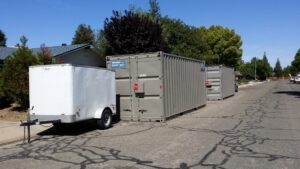
Prior to the start of the project, City crews work in the impacted areas to replace significant portions of deterioration in the roadway.
When the project begins, contracted crews prepare the area by removing weeds, trimming trees that may impact equipment, and sealing cracks in the asphalt. Crack sealing is an inexpensive method to prevent moisture from seeping into small cracks common in aging pavement.
How long does it take?
A few days, depending on weather and the size of the neighborhood.
What’s entailed?
Crack Sealing
– Quick-moving operation
– On-street parking affected
– Work zone protected by appropriate traffic control
Patching
– Localized failures fixed with asphalt
– Includes potholes, utility cuts, wide cracks, “alligator” cracking
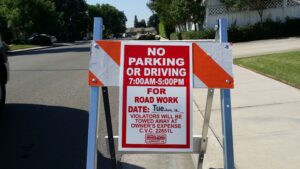
If the roadway is deteriorated enough, it will receive a treatment called a chip seal. This involves applying a tar-like substance on the existing roadway, followed by the placement of rock on the tar base. Lastly, we apply a fine rock and oil mixture called “slurry” over the entire road. This is applied either over the newly placed chip seal or the existing asphalt.
Notification
Notices will be distributed with dates and instructions.
Generally, No Parking signs will be posted in advance to help residents plan ahead.
TIPS: You will not be able to get out of your drive for a good portion of the day after a slurry surface is applied, so park your vehicle within walking distance if you need to leave after the start time.
If you need special arrangements, you can call your local crew supervisor whose number will be on your notice.
Day of Installation
Road Prep
– Cones are set out in preparation of the application truck coming through
– Manhole and utility covers are protected
TIP: This is a good indication that we’ll be applying the slurry seal shortly and there may be wet slurry in front of your driveway.
Sweep
– The road is swept to ensure a good bond
– Fairly fast-moving so it causes very little disruption to traffic or routine
TIP: Sweeping signifies that the slurry seal application is imminent and residents should exit their driveways now so as not to get blocked in by a lane of wet slurry.
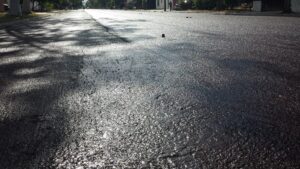
The treatment needs adequate time to dry. During this time, you can anticipate that your street will be closed for approximately 8-10 hours. That means no driving, cycling, or walking on the road. Driving on the road can leave your car a bit of a mess and leave tire tracks in the fresh oil, so please avoid doing so.
Once the street reopens, please use caution when driving on the newly treated surface, as hard braking or stationary turning of the wheel can cause scarring.
24-48 Hours After Application
Protecting Your Street’s New Surface
– Wet and freshly dried treatments are vulnerable to damage from vehicles
– High temperatures will soften any type of asphalt material
– Marks will appear from hard stationary turning and are unavoidable.
– Most of this type of marring will blend in over time
– This wear-in also applies to the initial surface texture
TIPS:
Avoid sitting still and turning your wheels or cutting the steering wheel hard like when backing out of a driveway.
Instead, back out and begin moving forward before turning your wheels.
Keep speeds low to moderate for at least 24 hours and a few days if it’s really hot outside.
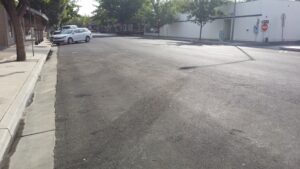
2-3 Weeks After Application
There Will Be Loose Aggregate
For the first couple of weeks after the install, it’s natural for some of the fine surface gravel to wear out of the slurry matrix as the surface wears in and smooths out.
The loose gravel is almost always no larger than 1/4 of an inch in diameter by design.
There will be places along the curb where loose aggregate can accumulate.
Feel free to sweep or blow any loose rock back into the roadway. Street sweepers will likely grab it the next time they make their way by.
1-3 Weeks After Application
Once the slurry seal has had sufficient time to cure and our installation punch-list has been finalized, we conduct a thorough quality control inspection. Please note that the timeframe for this varies depending on prevailing weather and traffic conditions. Our aim during this inspection is to ensure adherence to standards and confirm the seal’s effectiveness. Should there be an excess of loose material on the road surface, we will initiate a sweeping process to remove it.
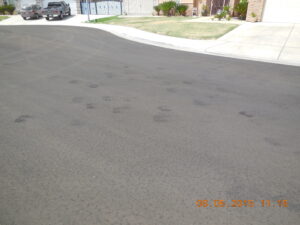
2 Weeks to Several Months After
The surface may initially show surface variations.
For the first couple of weeks to couple of months after the install, it’s also natural for the new surface to have some irregularities. These may include slight ridges, drag marks and/or color variations. In almost all cases, this is not bad work, but the nature of the treatment material and the best practices for installing it quickly and economically. City of Clovis staff will continuously monitor the progress of the project. If there are any abnormalities detected, they are put on a punch list to be corrected.
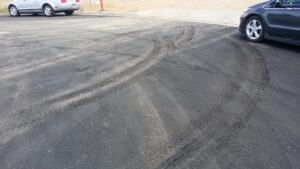
Scuffing
One aspect of pavement preservation with Slurry and Chip seal is their tendency to mar and scuff, especially when new in hot weather. Again, this is indicative of ALL asphalt products and is normal. Almost all scuffs fade given time.
FAQ
General Questions
A: Asphalt concrete pavement is a rigid surface that is designed to carry a load, whereas slurry is a topical treatment designed to prolong the life of the asphalt. Slurry is not meant to replace asphalt pavement and will not look like asphalt pavement once it is placed. Slurry will extend the life of the asphalt pavement by about 10 to 15 years.
A: Prior to the slurry curing, the oil that is found within the mixture looks brown. Once the slurry cures, it will turn black.
A: All affected residents were provided notification through social media, the City’s website, street signage, and door hangers provided by our contractors. If you don’t recall seeing a door hanger, they may have blown away in the wind or been intercepted by another member of your household.
A: Although the material is safe to drive on, it does not fully cure for approximately six months after deployment. Those blemishes are created by the use of power steering in vehicles. When the vehicle’s wheels turn without the car moving, it will create a divot.
A: Although not everyone perceives the smell of slurry in the same manner, some residents in the past have stated that slurry smells like gasoline. Rest assured that the scent is not gasoline, and the odor is not harmful to people.
A: No (but please don’t lick the street).
Parking & Driving
A: No parking signs will be affixed along your street(s) in the given time frames. Please abide by them.
A: Your vehicle will be towed by the City of Clovis Police Department.
A: Please contact Clovis PD’s non-emergency line at 559-324-2800.
A: Our contractors will delineate portions of your neighborhood for topical treatment. Those portions will change daily. Be on the lookout for “no parking” signs in your neighborhood. Park at the closest available curbside outside of the “no parking” areas.
A: Per the City of Clovis municipal code, non-operational vehicles are not allowed to be stored on City streets. Please have this vehicle moved prior to the beginning of the project.
A: General traffic control is utilized to prevent you from driving on the crack sealing material as it dries. If you see the crew on your street, please avoid driving in the area until the work is complete and it is safe to do so.
A: Cure time on this material is approximately 4-6 hours. The contractor will allow residents to drive on the road once the material has set through the deployment of traffic control devices.
Scheduling, Timing, & Special Circumstances
A: Although the City and their contractors attempt to adhere to the schedule that is published, the reality is that not all variables are able to be controlled by either party, and sometimes the schedule has to be shifted.
A: The scope and nature of the work would be highly impactful to residents throughout the city as it is not a quiet operation. The ability for the city to contact residents also becomes more problematic at night.
A: Unfortunately, we cannot. The schedule is based on limited time frames, and alterations made by the City can cost the taxpayers thousands of dollars.
A: The City of Clovis works diligently to plan around the CUSD academic calendar. Unfortunately, due to the temperature constraints that this material is subject to, we have a finite timetable to deploy this throughout the city. During that time, we actively attempt to avoid the CUSD events, but sometimes they do overlap.
A: Please schedule the moving company for alternative dates, either before or after the day your street is scheduled to be sealed.
A: The City makes every effort to avoid slurrying streets on trash pick-up days, though unfortunately, this isn’t always possible due to a variety of factors. If there are conflicts with either the contractor or the trash pick-up, the City will adapt and communicate any changes to the residents affected.
Cleaning Slurry & Loose Rocks
A: A simple online search for “how to get asphalt sealer off of my car” will prompt several recommendations. One method to remove asphalt sealer is simply to pour some mineral spirit onto a rag and gently scrub the stain off the vehicle.
A: A pressure washer should remove slurry from concrete if needed. If you’re unable to remove it yourself, please contact the contractor whose number is provided on the door hanger.
A: As this is a topical treatment, there will be sluffing of aggregates during the curing period. The majority of these rocks will be picked up by street sweepers over the course of the next six months.
A: The slurry aggregate that accumulates in the gutter pan is often tracked in on the bottom of your shoe. If you walk through slurry rocks, we recommend removing your shoes before entering your house.
Contractor Contact Information
Contractor:
VSS International
PO Box 981330
West Sacramento, CA 95798
(916) 373-1500 Office
Questions? Email Questions@Slurry.com and provide your address, phone number, and City location.
